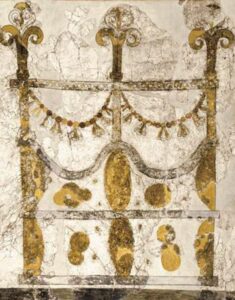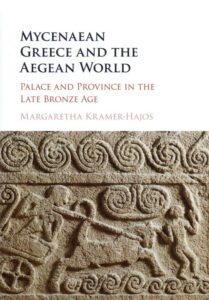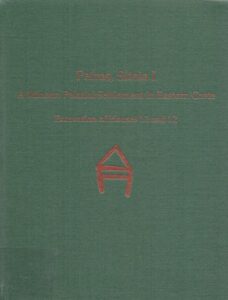ΑΡΘΡΑ | 2016
New geoarchaeological and palaeoenvironmental studies in Mani Peninsula (S. Peloponnesus) by employing luminescence dating techniques
Στο E. Photos-Jones, Y. Bassiakos, E. Filippaki, A. Hein, I. Karatasios, V. Kilikoglou & E. Kouloumpi (eds), 2016. Proceedings of the 6th Symposium of the Hellenic Society for Archaeometry (Bar International Series 2780), Oxford: 175-178.
Here, we attempt a comparison of the results achieved by both methods. The new luminescence ages estimated for littoral sediments allowed us to re-assess the eustatic, isostatic and tectonic changes during the aforementioned period of geological time. In addition, for the first time, we consider the contribution of airborne dust transferred from distant areas to the local sedimentary record with the intention of reconstructing patterns of atmospheric circulation over the Late Quaternary.Landscape evolution in the Kifissos floodplain
Στο E. Photos-Jones, Y. Bassiakos, E. Filippaki, A. Hein, I. Karatasios, V. Kilikoglou & E. Kouloumpi (eds), 2016. Proceedings of the 6th Symposium of the Hellenic Society for Archaeometry (Bar International Series 2780), Oxford: 161-166.
he effect of the mid-Holocene sea level highstand is confirmed as a contributing factor in the formation of the Piraeus early island, as narrated by Strabo, roughly in the period between 6000 and 5000 years before present. Meandering of the Kifissos River resulted in the formation of oxbow lakes which can be traced on modem topographic maps as closed depressions. A meander of the Kifissos River is delineated which flooded ancient sites in the 5th century BC near Plato’s Academy and he indicates that the statesman of Athens Cimon “converted the Academy from a waterless and arid spot into a well-watered grove” by digging channels for watering from this meander.Προϊστορική Θήρα
Αθήνα

Mycenaean Greece and the Aegean World. Palace and Province in the Late Bronze Age
Νέα Υόρκη

Βιβλιοκρισία του C. Thanos & W. Arentzen, Without Having Seen the Queen: The 1846 European Travel Journal of Heinrich Schliemann: A Transcription and Annotated Translation
Archaeologia Austriaca 100 (2016): 315-320
Kennell, S. A., Βιβλιοκρισία του: C. Thanos & W. Arentzen, Without Having Seen the Queen: The 1846 European Travel Journal of Heinrich Schliemann: A Transcription and Annotated Translation (Leiden 2012), Archaeologia Austriaca 100 (2016): 315-320.
Βιβλιοκρισία του P. Pavúk, Troia VI Früh und Mitte: Keramik, Stratigraphie, Chronologie, Studia Troica. Monographien 3
Archaeologia Austriaca 100 (2016): 288-291
Rutter, J. B., Βιβλιοκρισία του: P. Pavúk, Troia VI Früh und Mitte: Keramik, Stratigraphie, Chronologie, Studia Troica. Monographien 3 (Bonn 2014), Archaeologia Austriaca 100 (2016): 288-291
Βιβλιοκρισία του R. Jones, S. T. Levi, M. Bettelli & L. Vagnetti, Italo-Mycenaean Pottery: The Archaeological and Archaeometric Dimensions
Archaeologia Austriaca 100 (2016): 281-287
Jung, R., Βιβλιοκρισία του: R. Jones, S. T. Levi, M. Bettelli & L. Vagnetti, Italo-Mycenaean Pottery: The Archaeological and Archaeometric Dimensions (Rome 2014), Archaeologia Austriaca 100 (2016): 281-287.
Late Helladic and later reuse phases of Kastrouli settlement (Greece): Preliminary dating results
Mediterranean Archaeology & Archaeometry 16.3 (2016): 245-250
An initial archaeological reconnaissance of the partially looted site has produced some indication of use during late Helladic and later periods. Our four ages by luminescence and C-14 have shown that this site was used initially in Late Helladic period, and reused during the Middle Geometric, the Early Archaic and the Classical periods.Lithic Industries of the Aegean Upper Mesolithic
Mediterranean Archaeology & Archaeometry 16.3 (2016): 229-243
Recent research at Areta in the northern side of Chalki Island (Dodecanese) has revealed an enormous quantity of lithics of the Mesolithic period. It is the first time that such an old settlement is located in the area of the Dodecanese, thus extending to the southeast of the Aegean the already known Mesolithic network of sites and creating a sea route from Cyclades to Dodecanese.Petras, Siteia I. A Minoan Palatial Settlement in Eastern Crete. Excavations of Houses I.1 and I.2
Philadelphia, Pennsylvania

Metaphysis. Ritual, Myth and Symbolism in the Aegean Bronze Age
Leuven-Liege

